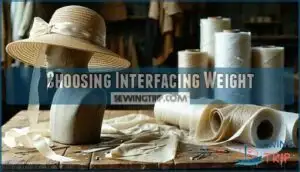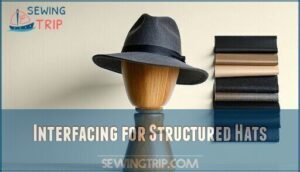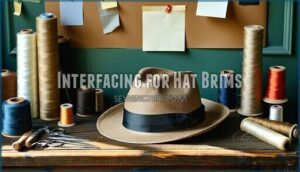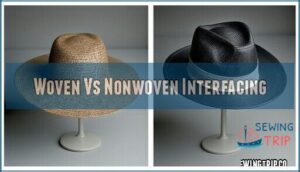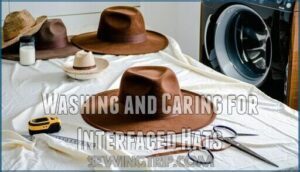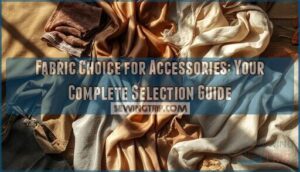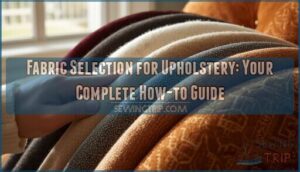This site is supported by our readers. We may earn a commission, at no cost to you, if you purchase through links.

For floppy sun hats and casual caps, choose lightweight interfacing that adds just enough structure while maintaining drape.
Structured hats like fedoras require medium to heavyweight interfacing for crisp shapes.
Match your interfacing weight to your fabric – heavy canvas needs sturdy support, while cotton needs gentler backing.
Fusible interfacing works great for beginners since it bonds with heat, but sew-in versions offer more flexibility for curved brims.
The secret lies in testing samples first – your fabric and interfacing should work together like dance partners, not fight each other, to achieve a perfect balance.
Table Of Contents
- Key Takeaways
- Interfacing for Hatmaking
- Choosing Interfacing Weight
- Interfacing for Floppy Hats
- Interfacing for Structured Hats
- Interfacing for Hat Brims
- Fusible Vs Sew-in Interfacing
- Woven Vs Nonwoven Interfacing
- Interfacing for Sun Hats
- Washing and Caring for Interfaced Hats
- Finding The Right Interfacing
- Frequently Asked Questions (FAQs)
- Conclusion
Key Takeaways
- Match interfacing weight to your hat style – You’ll need lightweight interfacing for floppy sun hats and casual caps, while structured hats like fedoras require medium to heavyweight interfacing for crisp shapes.
- Test samples before committing – You should always test interfacing with your specific fabric first, as your fabric and interfacing need to work together like dance partners for the perfect balance of structure and drape.
- Consider fusible vs. sew-in based on your needs – You can choose fusible interfacing for speed and convenience with heat-tolerant fabrics, or sew-in interfacing when you need flexibility during construction or you’re working with delicate materials.
- Pay special attention to brim support – You’ll want to match your interfacing choice to your brim’s intended function, using heavyweight options for brims that need serious structure and lighter weights for casual, flexible brims.
Interfacing for Hatmaking
Interfacing transforms ordinary fabric into structured hat-making material, providing the backbone your project needs.
You’ll choose between fusible and sew-in types, with weights ranging from featherlight to rigid depending on your hat’s intended shape.
Traditional millinery techniques relied on buckram and horsehair canvas as historical interfacing alternatives, while modern hat construction materials include specialized craft interfacings like Pellon 808.
For custom hats, consider using hair canvas interfacing to provide structure.
Consider sustainability considerations when selecting supplies—natural fiber interfacings often work better for blocking impact during shaping.
Your choice affects everything from brim stiffness to crown structure, making interfacing selection essential for successful millinery work.
Choosing Interfacing Weight
The interfacing weight you choose directly affects your hat’s structure and wearability.
Getting the balance right means your hat will hold its shape without feeling too stiff or remaining too floppy for its intended purpose, and this balance is crucial for the overall wearability.
Nonwoven Interfacing Stiffness
Nonwoven interfacing comes in various stiffness grades that directly impact your hat’s final structure.
Choose lightweight options for soft brims or heavier weights for structured designs.
- Fiber density determines how rigid your hat interfacing becomes after application
- Stiffness grades range from pliable craft weights to heavy-duty hat brim stiffener materials
- Brand comparisons reveal Pellon 808 offers moderate support while specialty hat stabilizer fabric provides maximum structure
Consider exploring options for nonwoven hat interfacing to find the perfect material.
Test layering effects before committing to your final design.
– Woven Interfacing Flexibility
Beyond simple stiffness, woven interfacing brings natural drape and grainline stability to your hat making projects. This fabric compatibility creates hat brim support that moves with you rather than fighting against natural movement.
| Interfacing Type | Best For | Flexibility Level |
|---|---|---|
| Cotton Broadcloth | Soft brims, everyday wear | High movement |
| Canvas Weight | Structured fedoras, sun protection | Medium flex |
| Muslin Backing | Delicate fabrics, vintage styles | Gentle support |
| Denim Weight | Heavy-duty outdoor hats | Firm structure |
| Linen Blend | Breathable summer hats | Natural drape |
The grainline impact matters here. Match your interfacing’s grain to your hat fabric for proper brim stiffness without unwanted pulling. For a variety of options, consider browsing cotton broadcloth choices.
Layering options work well too – combine lightweight woven with fusible for customized support. Sew-in benefits include adjustability during construction, letting you fine-tune that perfect balance between structure and comfort.
– Interfacing Weight Balance
Getting the fabric weight ratio right means your hat won’t collapse or feel like cardboard. You need interfacing that complements your outer fabric, not fights it.
- Match weights equally – Heavy fabric needs substantial interfacing compatibility
- Test stiffness vs. drape – Performance testing prevents disasters
- Consider layering considerations – Multiple thin layers beat one thick piece
Your hat interfacing weight should support the hat brim support without overwhelming the fabric’s natural movement.
You can find options for interfacing weight balance online. Perfect hat making interfacing creates stiffening hat brims that hold shape beautifully.
Interfacing for Floppy Hats
Creating delicate, droopy hat styles requires careful fabric selection and the right hat interfacing approach.
For floppy hats, you’ll want lightweight materials that provide subtle hat stability without sacrificing the natural drape.
Medium-weight nonwoven fusible interfacing works perfectly for crowns, adding mild structure while keeping soft structures intact.
Your brim support needs special attention.
Pellon 931TD offers gentle reinforcement, while fleece interfacing creates even softer results.
These flexible materials maintain the essential "flop" while adding durability to lightweight cotton shells.
Skip ultra-firm options like canvas or denim—they’ll turn your relaxed sunhat into a stiff mess.
When stiffening hat brims, cut interfacing slightly smaller than pattern pieces to reduce bulk.
Hat brim interfacing should feel barely noticeable when you run your fingers along the edge.
Fusible interfacing hats benefit from pressing in sections, allowing each area to cool completely before moving on.
Test samples first to verify your chosen interfacing creates the perfect balance of structure and flexibility.
To achieve a professional finish, consider using a sewing tutorial guide for your project.
Interfacing for Structured Hats
Structured hats demand heavyweight interfacing that won’t compromise under pressure. When you’re crafting fedoras, trilbies, or dress hats, your fabric selection becomes the backbone of professional results.
These interfacing types deliver the stiffness levels needed for lasting shape retention:
- Heavyweight woven interfacing – Provides natural drape while maintaining structure, perfect for premium hat construction
- Buckram or specialized foam interfacing – Creates extreme firmness for theatrical hats or dramatic silhouettes
- Double-sided fusible interfacing – Offers extra stability for complex crown shapes and reinforced panels
Your hat structure depends on matching interfacing stiffness to your design goals. Medium-weight fusible interfacing hats work well for everyday wear, while heavy-duty options support professional millinery.
Test different combinations – sometimes layering medium interfacing creates better results than single heavy layers. Remember that structured hats need interfacing weight equal to or slightly less than your outer fabric.
Hat brim interfacing requires special attention since brims endure the most handling and weather exposure. For ideal results, consider the fusible glue types when selecting your interfacing material.
Interfacing for Hat Brims
Brim stability transforms your handmade hats from floppy failures into professional-looking accessories. The secret lies in choosing the right interfacing types for your specific brim needs.
For structured hat brims requiring serious brim support, heavyweight nonwoven interfacing delivers maximum rigidity. Think fedoras and dress hats that need to maintain their shape through wind and weather. Medium-weight options work perfectly for everyday caps where you want hat structure without stiffness.
Fabric compatibility matters tremendously. Match your interfacing weight to your outer fabric – heavy duck cloth pairs with sturdy interfacing, while lightweight cotton needs gentler brim reinforcement. Woven interfacing follows your fabric’s grain, creating natural movement, while nonwoven provides consistent stability in all directions.
Crown support fabric often requires different treatment than brims. Test samples first to confirm your hat brim shaping achieves the perfect balance between structure and comfort. Interfacing for caps varies substantially from sun hat requirements.
Using the right hair canvas materials can also impact the overall quality of your hats. Remember, the right brim reinforcement makes the difference between amateur and professional results.
Fusible Vs Sew-in Interfacing
When you choose between fusible and sew-in interfacing for hats, you’re picking between speed and flexibility.
Fusible interfacing bonds permanently with heat, creating crisp structure in seconds. Sew-in methods require basting but offer adjustment freedom during construction.
Choose wisely: fusible speeds up your project, while sew-in gives you room to adjust.
| Factor | Fusible | Sew-In |
|---|---|---|
| Application Speed | Quick heat pressing | Time-intensive stitching |
| Fabric Compatibility | Heat-tolerant only | All fabric types |
| Durability | May bubble over time | Long-lasting bond |
Fusible types range from lightweight knits to rigid adhesive options, perfect for cotton and stable wovens. However, they can’t handle heat-sensitive fabrics like vinyl or sequined materials.
Sew-in interfacing works with any fabric, preventing glue bleed-through on delicate weaves.
Your hat interfacing choice depends on fabric compatibility and desired finish. Fusible delivers professional results quickly, while sew-in methods preserve fabric integrity.
Both interfacing weights should match your outer material for proper structure and drape in your finished hat making supplies.
Woven Vs Nonwoven Interfacing
Beyond the basic choice between interfacing types, understanding woven versus nonwoven options transforms your hat-making success.
Woven interfacing mimics fabric’s natural drape, maintaining flexibility while providing structure. Nonwoven interfacing delivers crisp stiffness but sacrifices softness.
Your material choice affects both appearance and durability.
| Feature | Woven Interfacing | Nonwoven Interfacing |
|---|---|---|
| Flexibility | Natural drape, fabric-like | Stiff, paper-like finish |
| Durability | Withstands washing, long-lasting | May break down over time |
| Cost | Higher price point | Budget-friendly option |
Consider your hat’s purpose when selecting interfacing weight and stiffness levels.
Woven varieties require grainline attention but reward you with seamless fabric integration. Nonwoven options cut in any direction, offering convenience for quick projects.
Test samples to achieve proper weight balance between your outer fabric and chosen interfacing for ideal results.
Interfacing for Sun Hats
Sun-hat interfacing transforms flimsy fabric into reliable shade protection. Your interfacing weight choice determines whether you get a structured parasol or a casual beach companion.
Medium-weight fusible interfacing works best for most Sun Hat Materials, providing ideal Hat Stiffness without creating board-like rigidity. For cotton sun hats, pair medium-weight interfacing with your outer fabric.
This combination delivers Brim Stability while maintaining comfortable flexibility. Heavy interfacing creates professional-looking brims that hold their shape through windy beach days. Light interfacing suits casual styles but may sacrifice durability.
Different Interfacing Types serve specific purposes. Fusible interfacing bonds quickly to heat-tolerant fabrics like cotton and linen. HeatnBond and Pellon brands offer reliable adhesion for woven materials.
For delicate fabrics, sew-in interfacing prevents heat damage while providing necessary structure. Test your Fabric Selection with interfacing samples before committing.
The perfect sun hat balances protection with comfort, requiring interfacing that supports without overwhelming your chosen materials.
Washing and Caring for Interfaced Hats
Proper care extends interfacing durability and maintains your hat’s structure. Hand wash interfaced hats in cool water with mild detergent, gently submerging for five to ten minutes. Avoid twisting the brim to prevent shape loss.
Machine washing works only with sturdy cotton hats using delicate cycles and hat cleaning cages. For hat washing success, rinse thoroughly and air dry on rounded forms or racks. Never use heat drying, which warps interfacing.
Store hats upside down on their crown with tissue paper supporting delicate areas. Clean sweatbands separately with gentle detergent. Follow care instructions from manufacturers, especially for specialty interfacing.
Spot clean stains promptly using mild oxygen bleach or white vinegar for salt rings. Test cleaning agents first to prevent fabric shrinkage or color bleeding. Pick up hats by the brim, not crown, minimizing stress on interfaced areas.
Finding The Right Interfacing
Finding the right interfacing requires testing samples with your specific fabric before committing to your entire project.
You’ll want to take into account your hat’s intended style and use – whether it needs flexibility for travel or stiffness to hold a sharp brim shape.
Test Samples
Smart sewers know that fabric testing saves headaches later.
Cut small interfacing swatches from your stash and pair them with your hat fabric.
Test how each combination drapes, feels, and holds its shape.
Try different interfacing weights to find your sweet spot.
Make mini hat prototypes with your top three choices.
Wash and dry these material trials to check durability.
The interfacing samples that maintain structure without becoming stiff win.
This simple step prevents costly mistakes on your final project.
Consider Hat Style and Use
Your Hat Style Guide starts with matching interfacing to your project’s needs.
A beach hat requires lightweight interfacing for flexibility, while a structured fedora needs medium-weight support.
Consider Design Considerations like washing frequency and wear conditions.
Fabric Selection affects interfacing weight – delicate fabrics need gentle support.
Hat Structure determines whether you’ll need stiff nonwoven or flexible woven types.
Different hat interfacing types serve specific hat making techniques, so match your interfacing weight to your hat design materials for best results.
Frequently Asked Questions (FAQs)
What weight interfacing for bucket hat?
Don’t put all your eggs in one basket when choosing weight. You’ll want medium-weight interfacing for bucket hats—it provides structure while keeping the brim flexible enough for practical wear.
Can you make a hat without interfacing?
You can make a hat without interfacing, but it’ll lack structure and shape retention.
The fabric will be flimsy and won’t hold its form well, especially for brims that need stiffness.
Can I use regular fabric instead of interfacing?
Yes, you can substitute regular fabric for interfacing.
Lightweight cotton, canvas, denim, or muslin work well.
Choose fabric that’s equal to or lighter than your hat fabric to avoid bulk while still providing structure.
How much interfacing do I need to buy?
Like measuring twice and cutting once, you’ll need enough interfacing to match each hat piece.
Buy the same yardage as your outer fabric, plus a quarter-yard extra for mistakes and testing samples, to ensure you have enough interfacing.
What happens if interfacing shrinks differently than fabric?
Different shrinkage rates cause puckering, warping, and distortion. Your hat won’t hold its intended shape. Pre-shrink both materials by washing or steam-pressing before construction to avoid this frustrating problem.
Can I remove fusible interfacing after applying it?
Once that fusible ship has sailed, you can’t easily remove it without damaging your fabric. Heat permanently bonds the adhesive, making removal nearly impossible without potentially ruining your project.
Should interfacing extend into seam allowances completely?
Interfacing should extend completely into seam allowances to provide full structural support throughout the hat construction.
This prevents weak spots where seams meet and guarantees consistent stiffness across all areas of your finished hat.
Conclusion
Perfect hat interfacing is like finding the right dance partner – it supports without overwhelming.
Remember that knowing what interfacing to use for hats depends on your specific project needs. Lightweight options work beautifully for casual sun hats, while structured fedoras demand medium-weight support.
Always test samples with your fabric first to verify compatibility. Match interfacing weight to both your fabric and intended hat style.
Whether you choose fusible or sew-in, the right interfacing transforms ordinary fabric into professional-looking headwear that holds its shape beautifully.
- https://www.youtube.com/watch?v=hw7o1sMXLSU
- https://mypacklove.com/blog/heat-transfer-labels/how-to-sew-a-hat-beginners-step-by-step-guide/
- https://www.reddit.com/r/sewing/comments/iaqas8/interfacing_for_a_hat_brim/
- https://janomelife.wordpress.com/2024/05/25/tips-tricks-for-sewing-bucket-hats/
- https://hatacademy.com/xn/detail/6485913:Comment:90577

